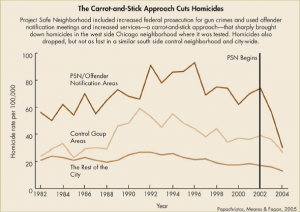Chronic Violent Offenders

Given that a small number of offenders drive the majority of violent crime, it makes sense to implement a crime reduction strategy aimed specifically toward these offenders. The focused deterrence model has proven effective for reducing crime among chronic violent offenders. This is true no matter at what stage an offender is notified in their criminal career. Some have notified just prior to release from prison or jail. Others have been notified with they are still out in the community. When faced with stiff penalties and a collaboration of law enforcement at the local, state, and federal levels, as well as community representatives, the message is pretty clear. Stop the violence, or face severe and certain consequences. When standards are violated, authorities will “pull every lever” available to ensure that violators are punished.
The Middle District of North Carolina (MDNC) has had great success implementing focused deterrence strategies across at least 11 sites. UNCG’s NC Network for Safe Communities created a Brochure to document MDNC sites’ successes in 2012.
Project Safe Neighborhoods (PSN)
PSN is a nationwide commitment aimed at reducing gun violence by networking law enforcement agencies, prosecutors, and resources. PSN is led by the US Attorney in the jurisdiction where it applied. While PSN is not solely a chronic offender model, its approach uses data to determine where crime reduction efforts should be aimed and which focused deterrence initiative would be most appropriate in a jurisdiction given the local context. A chronic violent offender strategy is one such initiative that may be adopted, but again data will drive the specific strategy.
For more information or to become a supporter of Project SAFE Neighborhoods please visit the Bureau of Justice Assistance







